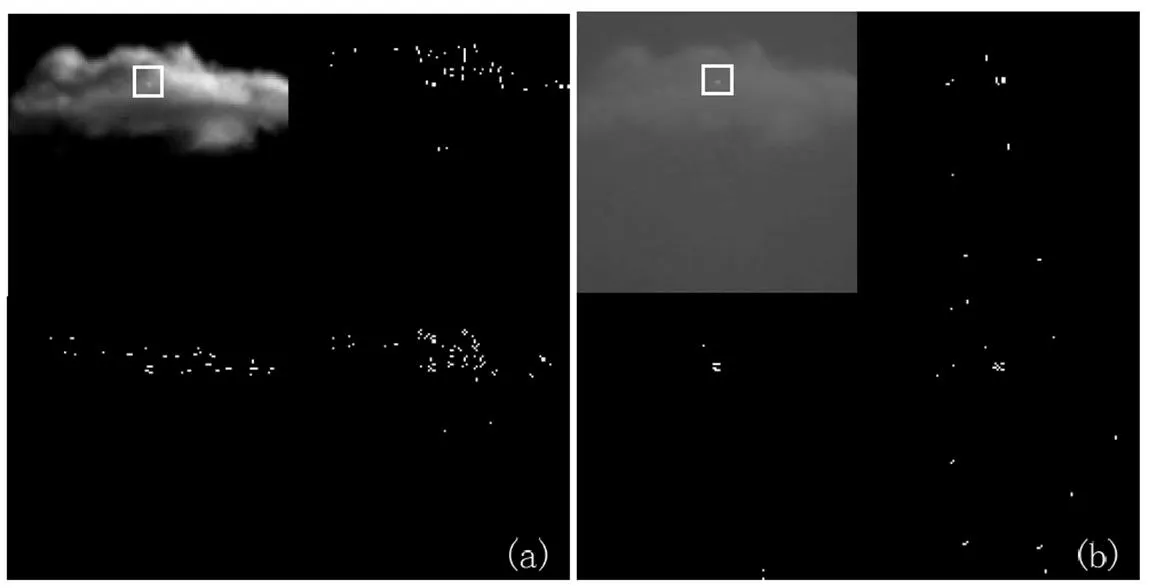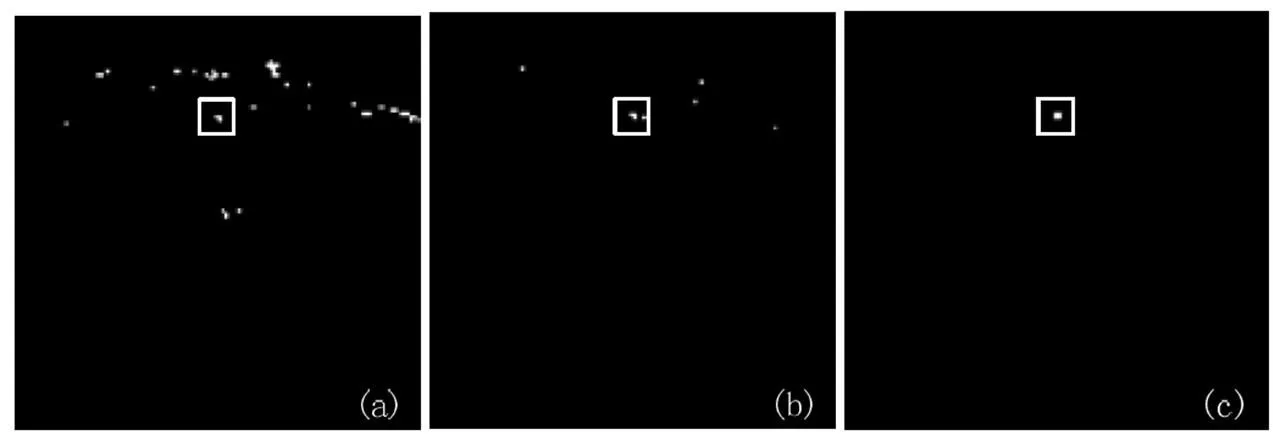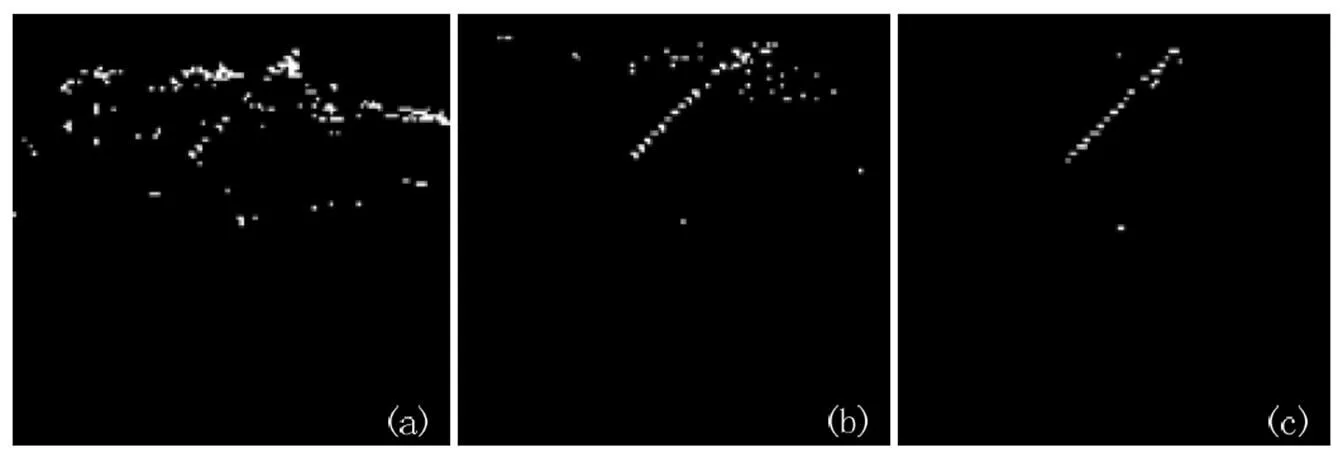A Dual-Band Infrared Dim Target Detection Algorithm Based on Wavelet Domain
2015-04-02SHIXiaogangBAIXiaodongLILijuanHANYumeng
SHI Xiao-gang,BAI Xiao-dong,LI Li-juan,HAN Yu-meng
A Dual-Band Infrared Dim Target Detection Algorithm Based on Wavelet Domain
SHI Xiao-gang,BAI Xiao-dong,LI Li-juan,HAN Yu-meng
(,471009,)
It is difficult to detect infrared dim target in single-band because the message acquired is relatively insufficient. Aimed at solving this problem, an algorithm for infrared dim target detection in dual-band based in wavelet domain is introduced. The dual-band images are decomposed by wavelet filters firstly, and the different methods which are used to ascertain the thresholds is introduced by the feature difference in the dual-band images, then the high frequency images are segmented by the corresponding thresholds. The high frequency segment images are fused with different Boolean logic strategies afterwards. Finally the dim target detection is accomplished by morphological operation and multiple frames accumulative detection.
dual-band,wavelet domain,dim target detection
0 INTRODUCTION
Infrared dim target detection is a key technology of infrared imaging guidance in complicated backgrounds, but with the development of photoelectricity technology, infrared detector noise, infrared background, long distance, the target’s low SNR, and so on, infrared dim target detection has become very hard. The current researches on infrared dim target detection almost are based on single-band image. The detection ability has became weak when the system faces to the complicated battlefield because the message acquired from the single-band detector is relatively insufficient. The researches on infrared dim target detection have turned into dual-band or multi-band fusion technology and good results have been achieved[1-4]. The essence of dim target detection is choosing the insular singular points in image, and wavelet transform can commendably distinguish the insular singular points (target) from the high frequency parts. So wavelet transforms are employed to research dual-band infrared dim target detection, which has became popular nowadays.
In this passage an algorithm of infrared dim target detection in dual-band based in wavelet domain is introduced. Firstly the dual-band images will be decomposed by wavelet filters, and the different methods which are used to ascertain the thresholds will be introduced by the feature difference in the dual-band images. Then the high-frequency images will be segmented by the corresponding thresholds. The high frequency segment images will be fused with different Boolean logic strategies afterwards. Finally the dim target detection will be accomplished by morphological operation and multiple frames accumu- lative detection. The experiments show that this algorithm has favorable infrared dim target detection ability and excellent real-time property.
1 WAVELET ANALYSIS OF INFRARED IMAGES
The wavelet generally has a good time resolution ratio and frequency resolution ratio whether in high frequency parts or in low frequency parts, so it can extract the message that is needed from the signal efficiently. The continuous wavelet transform can be defined as:

Whereis scale factor andis time-lapse factor, and() is basic wavelet function, but it cannot be applied easily in image analysis because the calculation is extremely complicated. The introduction of the Mallat wavelet fast algorithm can speed up the calculation of wavelet transform greatly in discrete decomposition, although the amount of calculation has been highly decreased while the quality of the image has not been obviously deteriorated yet, so it can be easily applied by hardware[5].
An infrared image can be decomposed into one low frequency part and three high frequency parts by wavelet filters. The low frequency reflects the character of the infrared background and the main characters of target are included in the high frequency parts. Fig.1(a) and (b) have given the dual-band images and their high frequency images decomposed by first-lever wavelet, the size of these images is 128×128. Obviously, most of the background has been filtered in these high frequency images, and the dim target is included in the collection of insular singular points.
2 ACHIEVEMENT OF THE AlGORITHM
The wavelet coefficients can be divided into two kinds. The first kind is acquired from backgrounds, these coefficients have a large number but low amplitude. The second kind is acquired from target and some background, these coefficients have a small number but high amplitude, so if we set up a threshold for coefficients, the coefficients which are larger than the threshold can be kept, and the others will be changed into zero. As we mentioned above, choosing a suitable threshold is extraordinary important in infrared dim target detection in wavelet domain.

Fig.1 Images decomposed by first-lever wavelet
The ability of the system’s detection could be improved greatly by using this method because the dual-band has more messages than the single-band. As is shown in Fig.1, the gray scale of the clouds changes fiercely and gray scale of the sky changes placidly in the band 1 image, while the gray scale of the clouds changes a little fiercely but the gray scale of some areas in the sky does not change placidly in the band 2 image. So after decomposition, the band 1 high frequency images have lots of noise points which almost come from the cloud while a few noise points come from the sky. The band 2 high frequency images have less noise points, but half these noise points come from the sky, and it has been found that the SNR of band 1 images are higher than band 2 corresponding images. Based on these characters a new dual-band infrared dim target detection algorithm is introduced. Firstly, according to the difference of the SNR, the method given by Donoho will be introduced to ascertain the threshold of band 1[6]:

Where1is the standard variance of high frequency image of band 1, andis the quantity of pixels.
The method given by literature 7 will be introduced to ascertain the threshold of band 2[7]:

Where2is standard variance of high frequency image of band 2,is the quantity of pixels, andis the floor number of wavelet decomposition.
The process of the algorithm is as follows:
Step 1: One group of cubic splines wavelet filters has been employed to decompose the dual-band infrared images and then we obtain a group of low frequency images and three groups of high frequency images. The directions of these images are horizontal, vertical and diagonal.
Step 2: Abandon the low frequency images, and the dual-band high frequency images will be segmented by the corresponding thresholds acquired by formula (2) and (3). The results have been shown in Fig.2(a)、(b).
Step 3: As is shown in Fig.2(a), the band 1 binary images have lots of noise points which almost come from the cloud, but a few noise points come from the sky. As is shown in Fig.2(b), the band 2 binary images have a few noise points but half of which come from the sky. According to this character, the high frequency binary images which have the same direction will be fused in OR operation to filter the most noise points, so we will obtain three different directional fusion images.

Fig.2 The high frequency segment image
Step 4: The position of the target will change in the process of convolution operation. Aimed at avoiding the departure of the target’s position in image segment, the three binary images will be fused in AND operation, so the dual-band images have been finally fused after this step.
Step 5: Considering the size of dim target is only a few pixels, we shall handle the fusion image in an open operation with a 2×1 template. This operation can not only eliminate some noises left but also decrease the size of target, because the size of the target may become larger after operating by step 4. The single frame detection has been finished after this step.
Step 6: The SNR of dim target is too low to detect exactly in single frame detection, so considering continuity of the target’s motion, and several frames accumulative detection will be employed to confirm the target. The algorithm will end after this step.
Aimed at proving the effect of our algorithm, a dual-band high-pass filtering fusion algorithm and a dual-band infrared dim target detection algorithm based on wavelet transform[8]are employed to compare with our algorithm. The former which is named as algorithm 1 will handle the dual-band images with high-pass filtering firstly. Then the self-adaption threshold will be introduced to segment the dual-band images respectively[9]:
=+S(4)
Whereis the mean of gray scale,is standard variance, and the range ofis from 1 to 4, so the single frame detection of algorithm 1 will be completed after the dual-band segment images are handled in AND operation. The latter which is named as algorithm 2 will fuse the dual-band images with the certain rule firstly, and then the fusion image will subtract the low frequency image in order to filter the background. The initial threshold is also acquired by formula 4. The gray scale of the filtering image will be changed to zero if it is lower than the threshold and the other will remain, so the new image is obtained and will also be handled in the same operation mentioned until new threshold is equal to the former threshold. The single frame detection of algorithm 2 will be completed after image is segmented by the threshold obtained finally. And then the several aspects will be employed to evaluate the performances of the three algorithms.
3 EVALUATION OF ALGORITHMS
Taking the dual-band images which are shown as Fig.1 for example, the results handled with three algorithms in single frame detection have been shown respectively as Fig.2(a)-(c), and=4.
As is shown inFig.3(a), the image which has been handled with algorithm 1 obviously contains a number of noise points, especially some noise points have the same size as the target, it will inevitably increase the detection difficulty of the system. As is shown in Fig.3(b), the number of noise points has been obviously decreased which means that the algorithm 2 does better in dim target detection. As is shown in Fig.3(c), our algorithm can detect the target exactly and have no noise point existing, which means that our algorithm does best in three algorithms above.

Fig.3 The results of single frame detection
Due to the existence of noise points, the dim target often cannot be detected exactly in single frame detection, so the guidance system often adopt the method of several frames accumulative detection to confirm the target because whose motion is continuous in accumulative frames. So the motion trails handled with three algorithms in several frames accumulative detection have been shown respectively in Fig.3(a)-(c), and the target is moving in line towards the bottom left from the primary coordinates(12,82).
As is shown in Fig.4(a), there are several broken parts in target’s motion trail which means that the algorithm 1 exists missing detection inevitably, so the guidance system need more frames to confirm the target. As is shown in Fig.4(b). The continuity of the target’s motion trail has become better after being handled with algorithm 2, but the previous motion trail is also not clear. As is shown in Fig.4(c), the continuity of the target’ motion trail is very clear after being handled with our algorithm, and therefore it also has better ability in several frames accumulative detection than the other two algorithms.
Detection ratio and false-alarm ratio will also be employed to evaluate the detection ability of the three algorithms. Firstly there are 200 frames dual-band infrared images have been chosen randomly which contains dim target to detect, the detection ratio is 87% and the false-alarm ratio is 18% when the algorithm 1 is adopted. The detection ratio is 96% and the false-alarm ratio is 8% when the algorithm 2 is adopted, and the detection ratio is 97% and the false-alarm ratio is 3% when our algorithm is adopted, so it can be seen that our algorithm can obtain a preferable detection ratio while decreasing the false-alarm ratio obviously. The real-time also will be employed to evaluate the three algorithms. The results have been given by table 1.

Fig.4 The motion trails of continuous frames detection

Table 1 Evaluation of real-time
As is shown in table 1,algorithm 1 has the least average single frame operating time than the other two, but the discontinuity of its trail has led the guidance system need at least 8 frames to confirm the target, so algorithm 1 have to take the longest total time in target detection. Algorithm 2 and our algorithm usually need 2-3 frames to confirm the target in accumulative frame detection, but the average single frame operating time of algorithm 2 is two times as long as ours which is attributed to wavelet inverse transform and choosing the threshold. It also needs more time to confirm the target than ours, so our algorithm has a good real-time obviously. As far as these evaluating factors we have discussed, our algorithm has not only favorable ability of dim target detection but also the good real-time compared with the other two algorithms.
4 CONCLUSIONS
A algorithm of infrared dim target detection in dual-band based on wavelet domain is introduced in the passage. The dual-band images are decomposed by wavelet filter firstly, and different methods which are used to ascertain the thresholds will be introduced by the feature difference of the dual-band images. Then the high frequency images will be segmented by corresponding thresholds, after that the high frequency segment images will be fused with different Boolean logic strategies. Finally the dim target detection is accomplished by morphological operation and multiple frames accumulative detection. The experiments show that this algorithm has favorable ability of infrared dim target detection and excellent real-time property.
[1] BAI Xiao-dong, LIU Dai-jun. The deliberate of demonstration confirmation about the precision guidance weapon technology[J]., 2004, 5(6): 40-42.
白晓东, 刘代军. 关于精确制导武器制导技术演示验证的思考[J]. 航空兵器, 2004, 5(6): 40-42.
[2] SHI Xiao-hua, ZHANG Tong-he. The counter-countermeasures techno- logy for dual-band multi-element IR seeker[J]., 2009, 31(6): 311-314.
史晓华, 张同贺. 红外双色多元导引头抗干扰技术研究[J]. 红外技术, 2009, 31(6): 311-314.
[3] ZONG Si-guang, WANG Jiang-an, MA Zhi-guo. New detection algorithm of weak targets on double bands under strong clutter[J]., 2005, 27(1): 57-61.
宗思光, 王江安, 马治国. 强杂波中双波段目标检测新算法[J]. 红外技术, 2005, 27(1): 57-61.
[4] LI Qiu-hua, DU Yi. The algorithm of two color IR small extended target precision segmentation based on multiple features integration[J]., 2009, 31(2): 112-118.
李秋华, 杜鹢. 基于多特征整合的双色红外小扩展目标精确分割算法[J]. 红外技术, 2009, 31(2): 112-118.
[5] Mallats S G. Multifrequency channel decomposition of images and wavelet models[J]., 1989, 37(12): 2091-2110.
[6] Donoho D L. Denoising by soft-thresholding[J]., 1995, 41(3): 613-627.
[7] Zhao ruizhen, Song Guoxiang, Wang Hong. Better threshold estimation of wavelet coefficients for improving denoising[J]., 2001, 19(4): 625-628.
赵瑞珍, 宋国乡, 王红. 小波系数阈值估计的改进模型[J]. 西北工业大学学报, 2001, 19(4): 625-628.
[8] SUN Yu-Qiu, TIAN Jin-wen, LIU Jian. Dual band infrared image fusion detection based on wavelet transform[J]., 2007, 36(2): 240-243.
孙玉秋, 田金文, 柳健. 基于小波变换的双色红外图像融合检测方[J]. 红外与激光工程, 2007, 36(2): 240-243.
[9] WEI Dao-zhi, HUANG Shu-cai, XIA Xun-hui. Temporal-spatial fusion filtering algorithm for small infrared target detection[J]., 2014, 36(11): 905-908.
韦道知, 黄树彩, 夏训辉. 基于时空域融合滤波的小目标检测算法[J]. 红外技术, 2014, 36(11): 905-908.
一种基于小波域的双色红外弱小目标检测算法
史晓刚,白晓东,李丽娟,韩宇萌
(中国空空导弹研究院,河南 洛阳 471009)
针对单波段红外弱小目标检测难度大、信息量少的问题,提出一种基于小波域的双色红外弱小目标检测算法。首先运用小波滤波器对双色图像进行分解,利用双色图像的特征差异提出了不同的阈值确定方法对高频图像进行分割,通过采用不同策略的布尔逻辑运算完成高频分割图像的融合,最后运用形态学运算和多帧累积检测的方法完成弱小目标的检测。
双色红外;小波域;弱小目标检测
TP391
A
1001-8891(2015)12-1027-05
2015-06-24;
2015-09-23.
史晓刚(1982-),男,河南舞阳人,博士研究生,主要从事红外成像制导方向的研究工作。
航空科学基金项目,编号:20110112007。
